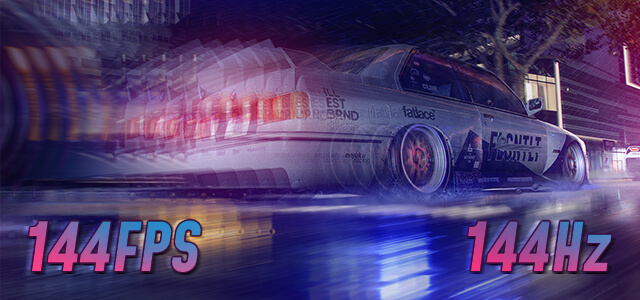
As one of the world’s leading builders of gaming PCs, a common question we often receive is how refresh rate and frame rate differ and which is the most important spec for gaming. Read on as we break down each and discuss the hardware we recommend for the best gaming experience.
Refresh Rate vs Frame Rate – Compare and Contrast
Both refresh rate and frame rate are measures of how many times a still image is displayed per second. Just like with movies recorded on film, it’s the rapid refresh of still images within a game that provides the illusion of movement to the eye. Generally speaking for gaming, a higher rate means a smoother, more fluid display and more immersive experience. Lower rates will make your game feel choppy, laggy, and if low enough, unplayable.
It’s important to understand, that even though they’re often used synonymously, refresh rate and frame rate are not the same thing. Frame rate is the number of still images generated by your GPU – and to a lesser extent CPU – while in game. It’s measured in Frames Per Second (FPS) and is often the main benchmark used when evaluating the hardware power of a gaming PC.
Refresh rate, measured in Hertz (Hz), is how quickly a display can refresh an image. Similar to FPS, the higher the refresh rate, the smoother the game or video will appear. With HD and 4K TVs, poor refresh rates result in what’s described as “motion blur.” While FPS is a PC spec, refresh rate is purely a spec of the monitor or display itself.
Which is more important for gaming?
Both are important specs for gaming and ideally, you want PC hardware that will push a similar FPS to the Hz refresh rate of your monitor. This is because you’ll essentially be capped at whatever that lower spec is. For example, a 60Hz monitor will only be able to refresh 60 times a minute, even if your PC is pushing 150+ frames per minute. Conversely, a 144Hz monitor will not display true 144Hz if the PC hardware is only pushing 60 FPS.
How to maximize frame rate and refresh rate?
Since refresh rate is a display spec, you’ll want to make sure you’re starting with a high refresh rate monitor. For gaming, 120-144Hz is what we recommend. You’ll also want to make sure you connect the GPU to a high refresh rate monitor via DisplayPort as most versions of HDMI cap at 60Hz.
Frame rate depends on factors like in game detail settings and display resolution, but starts with the hardware itself, with the graphics card being the single most important driver of high gaming frame rates. For FPS around 140+ at 1080p, we recommend a mid-tier card like Geforce GTX 1660 Ti or RTX 2060. At 4K, you’ll want a more robust RTX 2080 Super or 2080 Ti. CPU power is a factor as well but most games are still single threaded, so the highest single core boost speed available will yield the best results.
How do G-Sync and FreeSync come into play?
G-Sync and FreeSync are two similar technologies developed by NVIDIA and AMD respectively, designed to reduce frame tearing and stutter associated with broken frames or hardware hiccups. The technology doesn’t directly affect frame rate or refresh rate, but instead improves the overall display quality while in game. Usually gaming monitors come with either G-Sync or FreeSync but not both and they are proprietary to the graphics card and drivers, so make sure your monitor features match your current hardware for maximum effect.
More questions? Let us know in the comments or give us a call at 804-419-0900. Or configure your gaming system for maximum FPS right here!
Josh Covington
Latest posts by Josh Covington (see all)
- What is CUDIMM? - January 29, 2025
- X870 vs B850: Choosing the Right Motherboard for Your Build - January 17, 2025
- How Much Power Supply do I Need? - January 15, 2025